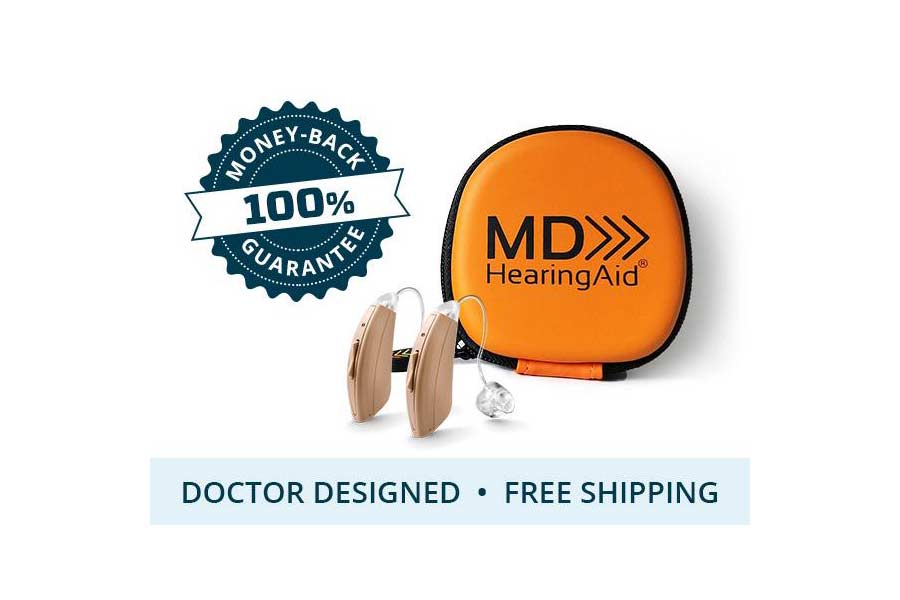MD Hearing Aids have been selling hearing aids online in the United States for many years. They offer several hearing aid products direct to consumers on their website. One of their products, in particular, caught my attention, the LifeEar Core is a self-programmable set of twin-mic digital hearing aids on sale for just under $1200 with a 45-day money-back guarantee. When you compare that to modern hearing aid technology that is definitely at a cheaper end. MD Hearing Aids say that all their hearing aids are high-quality, FDA-registered medical devices. That means that the LifeEar Core is basically a true hearing aid, but unlike most true hearing aids, it is self-programmable by the user. Let's talk about the devices and my experiences with them.

First off, I would like to speak about the packaging, while I know it is an inconsequential thing really, I think it was excellent. I have spoken about this before in relation to another online hearing aid provider called Eargo. MD Hearing Aids have thought through the packaging of their aids and they present them very well. It is reminiscent of the way high-end consumer electronics are packaged and presented. I have said it before, traditional hearing aid manufacturers should take note.
In the box, you get the hearing aids set up with thin tubes and instant fit open tips. A quick start guide, a larger manual, a cleaning tool, some 312 batteries and spare thin-tubes and closed instant fit tips. The devices are twin-microphone, thin-tube, digital Behind The Ear Hearing aids with a pushbutton. Using thin-tubes probably makes a lot of sense.
Thin-tubes are quite discreet and tend to sit well against the side of the face. The tube carries the sound from the hearing aid at the back of your ear into your ear canal. The beauty of thin-tubes is that the receiver is protected in the hearing aid, whereas with Receiver In Canal devices, the receiver is exposed to the ear canal and can fail if wax or moisture gets into it. It means that a thin-tube hearing aid should be more reliable and less prone to failure. That has to be seen as a good thing when you are buying hearing aids online.
The devices are quite discreet on the ear and feel pretty comfortable. The thin tube sat well against the side of my face and was relatively discreet. I used the open tip that was fixed to the device because my hearing loss is basically a high-frequency one. The tips are very comfortable and actually fitted my ears very well. In fact, I like the tips quite a bit. The pushbutton on the back of the aid was easy to find and use.
Setting Them Up
The hearing aids are set up using a smartphone app that can be downloaded from the Apple or Google store. Set up is easy enough and the quickstart guide gives a pretty good run through. Setting them up takes a while, you need to go through a setup process involving listening to tones. The tones are presented through the hearing aids and are not unlike an air conduction hearing test. Find a very quiet place to do it, it will take a while as it goes through a couple of frequencies for each ear. Once you go through the process, the aids are set up for your hearing and you are good to go.
The app also acts as a remote control, you can use it to switch between the different pre-set programmes and control the volume of the aids. The volume of each aid can be independently set through the app. If you change the programme or the volume on the app, it will change in both hearing aids. The pre-set programmes are an automatic programme, a quiet programme, a programme focused on speech, and a Restaurant programme.

There is also the opportunity to change the sound that is presented to you with an equalizer tool. In essence, it gives you separate control over the lows, mid and highs. It can help make the sound a little sharper, or add some bass if you are looking for that. Another screen will allow you to affect how much noise reduction is working on the aids. The noise reduction appears to be mostly steady-state noise reduction, so it is good for non-changing background noise like a fan, or the hum of a pump or refrigerator, not necessarily for dynamic noise.
While I didn't put them through a test box scenario, it appeared to me that the aids reacted to noisy situations by using the directional microphones to focus forward and they dropped the low-frequency amplification. Again, this makes sense as it is basically the strategy that most entry-level hearing aids follow.
The feedback manager worked pretty well for me, however, if I changed the feedback path by putting my hand up near my ear, I got a little whistle. I could have changed the tip to the closed tip and it might have eliminated the problem, but that would have stuffed up my ears. I decided to just go ahead with the set-up and see how it worked out.
Wearing Them
So I wore them for a couple of days and found them to be adequate. The sound was pretty good and gave me the speech cues I needed in most situations. The Restaurant setting wasn't actually bad, it definitely gave me a bit of help in a noisy cafe. Being able to adjust the sound on the go was really helpful, it allowed me to boost the high-frequency sounds when I needed to. The automatic programme seemed to work generally well, it definitely made changes as I moved through different soundscapes, although I think using the separate pre-sets was better, in particular in noisy situations.
I had some problems with the connection between the app and the hearing aids. Once or twice, it seemed to me like the left hearing aid muted or turned off.
What I lIked
I really like the self-programming system and the power that the app offers you. The ability to change the way the sound is presented on the go is essential in my opinion. I found the devices really comfortable and as I said the tips were great. The sound quality was not bad, it wasn't the same as my LiNX Quattros, but that's understandable. They helped with speech intelligibility in several situations, including complex noisy situations. So overall, I was happy with them considering the pricing.
What I don't Like
While I said that I like the self-programming system, I also see it as something that could be problematic. Let me explain, You can go through the self-testing system with ease, setting up the hearing aids to your own needs. The problem I see is that there is no readout of that testing. This isn't something that just MD Hearing Aids suffer from, NuHeara's excellent system is the same. In fact, the only system I have seen that gives you an audiogram like readout is the BeHear system.
The reason I see this as an issue is that if there is no audiogram type readout, there is no opportunity for you or anyone else to see if there is a possible referrable issue. The second thing that I don't like about these types of devices is that of course, you don't get a full hearing test including bone conduction. Therefore, you may not be programming the hearing aids to your amplification needs.
Don't get me wrong, this isn't a criticism of MD Hearing or this hearing aid. It is an observation of the drawbacks I see with self-programming hearing aids. I think that there will be an explosion of demand for these type of devices, and MD Hearing and others like them, are well placed to service that demand. However, to truly deliver devices that service needs and protect consumers from themselves, MD Hearing and others like them need to look at how they can manage that.
In Finishing
These aren't a bad set of hearing aids, they don't sound bad at all and they deliver speech intelligibility in several different sound environments. They are offered at a pretty solid price. I would say to you if you know that you have a run of the mill mild to moderate hearing loss with no complications. If you are tech-savvy and not afraid of a smartphone, and if $1200 is your price range. Well, then these aren't a terrible bet, especially with the 45-day money-back guarantee.
Like us on Facebook by clicking the button below to keep up with our latest utterances. Alternatively, if you don't like Facebook, sign up to the newsletter below. It is important to remember, a hearing aid isn't properly fitted unless they do Real Ear Measurement.










